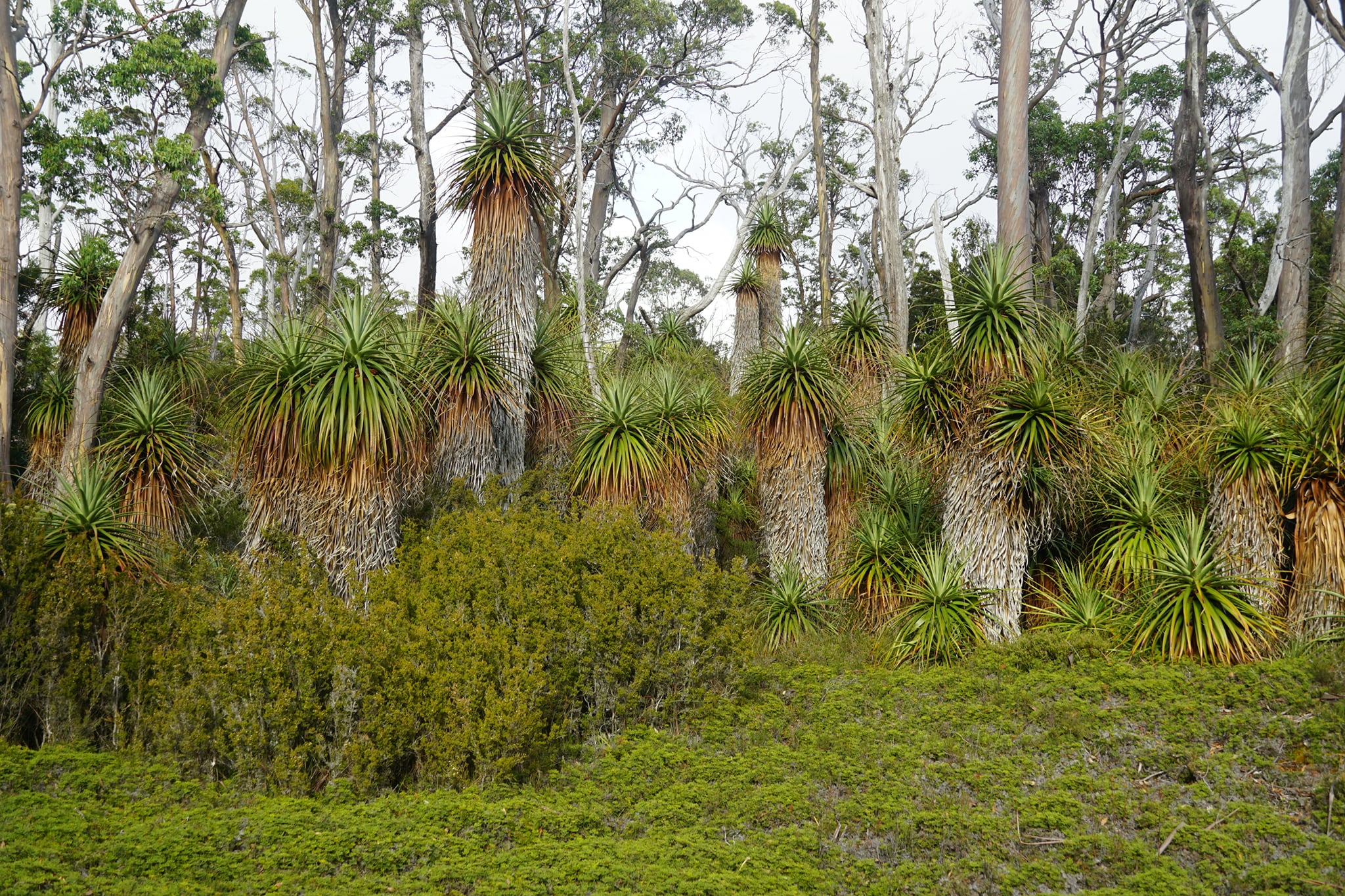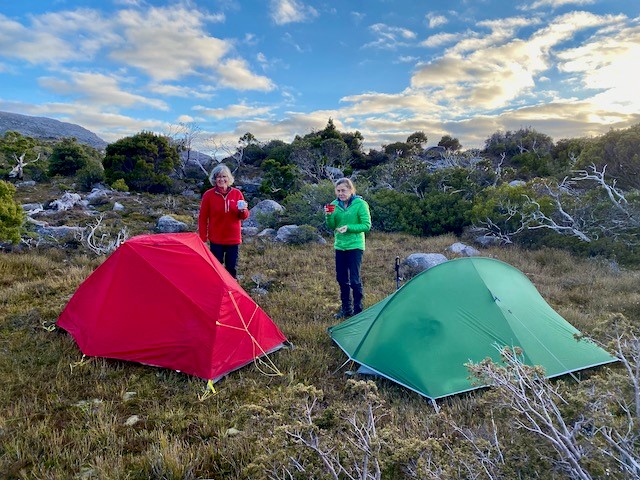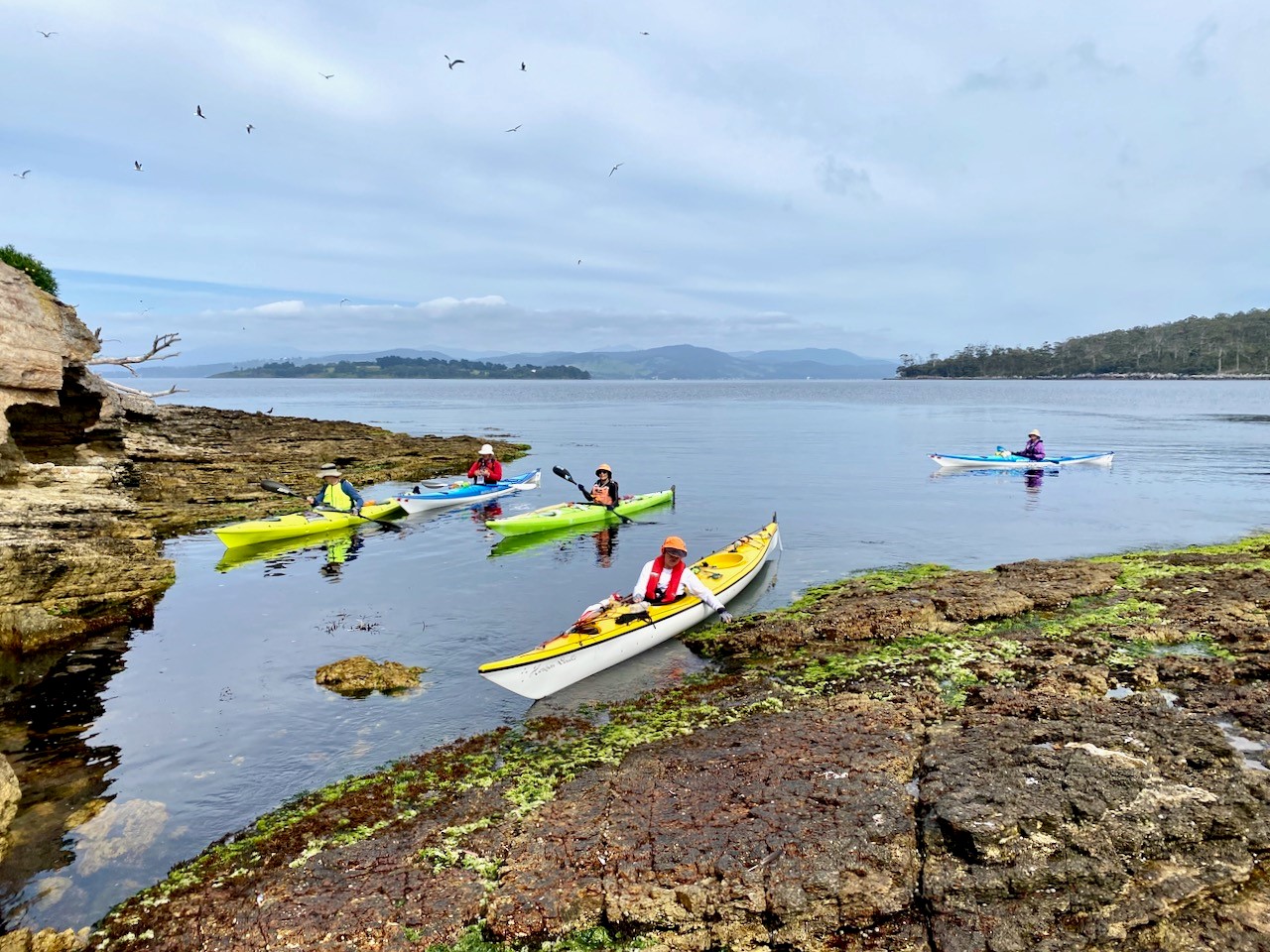Richea pandanifolia after which the club is named

Welcome to the Pandani Bushwalking Club
Join Pandani and enjoy Tasmania's natural wonders
The Pandani Bushwalking Club organises walks and other activities in the southern Tasmania region and further afield on weekends and weekdays all year round.
The emphasis is on bushwalking but there are also kayaking and other evens, including social activities held at various times of the year. Many club members are keen bush photographers and an annual photographic competition and exhibition is held each year.
The Pandani Bushwalking Club became a fully incorporated body on 19 June 1992. The club was formed primarily by people who had been through the Adult Education ‘Introduction to Bushwalking’ course in the late 1980s and who had continued to walk together as friends after completing the course.
The club’s declared objects and purposes were "To participate in, and promote, safe bushwalking and associated activities ...".
The founders envisaged an informal, friendly club catering for all walkers from inexperienced to hard-core. They aimed to provide a supportive introduction to the Tasmanian bush. The club continues to follow these founding principles.

WHY JOIN PANDANI
Find new Friends
Get Fit
Have lots of Fun
Explore Tasmania

Notices
Notices
Staying COVID Safe when Participating in Club Activities
The Pandani Committee encourages members to manage the ongoing risk of COVID when participating in club activities by key behaviors. The behaviours are a recommendation of the Tasmanian Government to assist in the protection of all Tasmanians. More information is provided in the member area.
For up-to-date information and advice on coronavirus visit https://www.coronavirus.tas.gov.au
National parks and reserves are mostly open to the public, this includes campgrounds and visitor centres. Visit https://www.parks.tas.gov.au for details.
• • • Flash walks - Continue to be advertised on the Facebook page.
Pandani Bushwalking Club Committee
Walks Information
Information for Participants
Registering for a walk
To meet Club requirements, all intending participants must book as detailed in the program summary for that activity. Please remember to check the grading prior to booking and if you have any doubts or a medical condition that may affect you ability, discuss with the Organiser. Phone the leader early rather than late, or you might miss out as some trips have a participant limit!Minimum equipment
As a minimum it is expected that participants will carry sufficient water and food for the planned trip, basic first aid equipment and appropriate clothing and footwear for the conditions likely to be met – bearing in mind that Tasmanian weather is changeable and may be cold, wet and windy even in summer. JEANS or similar are NOT considered appropriate for bushwalking. More details of recommended gear can be found in your Program.Trip Gradings
Easy – a walk of up to 10 kilometres along a generally flat, well formed track or beach. These walks are often suitable for families with small children – enquire with the Organiser. The walking time is usually up to about 4 hours.Easy - Medium – a walk that anyone of reasonable fitness would still find relatively easy bu may extend to about 12 kilometres distance in a day with some hills, although no sustained or steep climbs. The walking time is usually up to about 5 hours.
Medium – a reasonably solid day’s walk for most bushwalkers but not in the arduous category. Up to to a maximum of fifteen kilometres distance along a reasonably well formed track with individual climbs of no more than 250 metres along the way. Alternatively, the distance travelled may be only a few kilometres but the walking may involve a sustained climb, rough or scrubby terrain or snow covered ground. Usually 6 to 7 hours walking involved.
Medium - Hard – starting to get into the category of "for enthusiasts only"?. Usually will involve a significant distance (greater than 12 kilometres) combined with a sustained climb of up to 1000 metres and/or rough and scrubby terrain. May involve eight or nine hours walking in a day. Such trips can still be suitable for people of limited bushwalking experience provided they are well equipped and have a better than average level of fitness. If you think you fall into this category and want to go on a medium-hard graded trip discuss with the trip Organiser or another experienced Club member before committing yourself to it.
Hard – Remote and challenging walking. Will include off track or difficult terrain. Be prepared for thick scrub, rock scrambling, mud, uneven and undeveloped surfaces and steep sustained ascents and descents. Generally up to 10 hours walking in a day, at a sustained pace. (Not including breaks.) Only for experienced walkers and not suitable for beginners. Will also generally involve a long drive to the trail head. An overnight hard walk is only for strong fit walkers.
Transport
Where possible car pooling is arranged from the meeting place. Currently 40 cents per kilometre per car is recommended, divided equally among ALL occupants of the car (usually 4 people). This amount is a guide only and can be varied at the discretion of the driver depending on the condition of the roads, the number of passengers per car and other factors. Park admission and camping fees are additional costs which Organisers should list separately.Notice to all Participants
Prospective participants should check with the Organiser that they are capable of completing the proposed trip based on their previous experience, fitness and personal capabilities. Participants should also ask the Organiser what the trip entails and what food, equipment or special skills are required. Conversely, Organisers will attempt to ensure these points are checked and may reject an applicant they consider unsuitable for the trip.Check-in system
The Club has a check-in system in place where the Organiser must register all participants prior to the walk and confirm safe completion of the walk on return. The Club’s search and rescue procedures will be activated if there is no confirmation.Equipment loans
The Club has some items of bush walking equipment for loan to those members starting out or requiring it only occasionally.
Training and Safety
Training and Safety
The club has a Mentor Program for new Walks Organisers to assist in the leading of at least the first trip with the club. Information on mentoring is available in the current Program. It is the responsibility of a club member leading their first trip to organise a mentor to accompany them and to help answer any questions they may have. A mentor must also be organised when leading a trip out of the normal range of experience, for example, when leading an overnight trip, after first leading day walks. Mentors may be a good source of information on a particular area or trip.
All Pandani leaders are issued with a copy of the Pandani Leaders Manual. In addition, the Club has bought a number of copies of the Hobart Walking Club publication, Safety in the Bush, which are available to new leaders from the Walks Program Coordinator.
Walkers intending to visit remote areas, either on day walks or on overnight trips, are recommended to read the information on Minimal Impact Bushwalking.
In addition, the Club also runs navigation classes from time to time, generally in the Autumn and Winter programs and members who wish to become competent bush navigators are encouraged to take them. From time to time, experienced members may also run training sessions, advertised in the Program. Members are reminded to book in before the session, rather than just turning up. It is also recommended that walks organisers have a current First Aid Certificate. The club does not run first aid courses.
The monthly Social Meetings are frequently a source of information on the latest gear, as is the club Facebook page.
Finally, novice walkers are recommended to read the information in the Program about wet weather gear and appropriate clothing and footwear for bushwalking.
Useful Links
Useful Links
|
Links to Tasmania Walking Clubs
There are several other organisations in the Pandani region that offer outdoor activities. Roll over the links, if one interests you, click on the name to visit that site. Hobart Walking Club
Launceston Ramblers Club Launceston Walking Club North West Walking Club Circular Head Walking Club Links to other bushwalking related organisations in Australia From these links you can find out about other organisations in Australia. Roll over the links, if one interests you, click on the name to visit that site. Bushwalking Victoria
Walking South Australia Bushwalking Queensland Federation of WA Bushwalkers Parks and Wildlife Tasmania – Facebook page Tasmania National Parks Association Links to other useful and Interesting sites Find out about walks in Australia and the world, download tracks, visualise a track on Google Earth. Roll over the links, if one interests you, click on the name to visit that site.Australian Alps National Parks Every Trail Great Walk Magazine John Chapman Bushwalking New Zealand Tramper Otago Youth Adventure Trust Photodiary of a Nomad Walkopedia Walking New Zealand magazine Wild Magazine RockMonkeyAdventures Naturelover’s Walks LISTmap MetEye Weather Blank Bushwalk.com |
Minimal Impact Bushwalking
Minimal Impact Bushwalking
Respect the enjoyment of others. Be considerate of others in your group and other walkers as they too have come to enjoy the bush. For many this means enjoying the peace and quiet the bush has to offer.
Group Size. The maximum number in a group should be based on the sensitivity of the area to be visited, the condition of and impact on the tracks, the length of the walk, the season/weather, available campsites. Suggested limits are: sensitive/alpine areas - maximum 10; other parks/reserves/walk areas - maximum 20
Stay on the track. Keeping to established tracks where possible and not cutting corners minimizes damage. Avoid walking on sensitive vegetation if possible. In open, untracked country spread out to disperse the damage. A plant stepped on only once has a much better chance of survival than if it is trampled by the whole party. Route planning should try to avoid sensitive vegetation and cultural areas.
Carry out all rubbish. If you can carry it in you can carry it out. Leave excess packaging at home. Don’t burn or bury rubbish as animals are likely to dig it up and scatter it. Rubbish left behind is unsightly as it does not belong in the bush and may take years to break down. Here is a list of decomposition times for some items:
Faeces: 2 weeks
Cotton rag: 1-5 months
Food: 2 months
Orange peel: 2 years
Cigarette: 5 years
Plastic bag: 30 years
Tin can: 100 years
Aluminum can: 200-500 years
Foil: indefinitely
Minimise spreading disease such as Phytophthora. Phytophthora (dieback) is a soil borne disease which can be spread by bushwalkers. Avoid areas of Phytophthora if possible. Thoroughly clean boots, tents, groundsheets and even vehicle tyres after (and during if indicated) a trip.
Take care of huts. Leave them clean and tidy for the next visitors. Be careful with fires in huts. Several huts have been lost because of accidents with fire or stoves. Don’t leave food as it encourages rats.
If there is a toilet use it. If not bury faecal waste at least 15cm (6 inches) deep and at least 100m away from watercourses and campsites. In the snow be sure to dig down into the soil. Consider using unbleached, undyed toilet paper which breaks down more quickly than those containing dyes.
Fires. Observe fuel stove only areas. Observe any fire lighting restrictions. Keep the fire small and if possible use an existing fireplace. Use only dead or fallen timber. Be absolutely sure the fire is out before you leave. Put it out with water not soil. In peat areas fires can smoulder underground for months.
Water. Don’t put food wastes or wash-up water in stream or lakes. Detergent, toothpaste and soap harm fish and other waterlife. Wash at least 50 meters from streams and lakes and scatter the water when finished. Soap is not necessary for dishes, use a scourer.
Campsites. Use existing sites if possible. Camp on hard or sandy ground where it will cause less damage than on boggy or lush vegetated ground. Digging trenches around tents should be unnecessary. Always leave your campsites in better condition than you found them even if this means carrying out other people’s rubbish.
